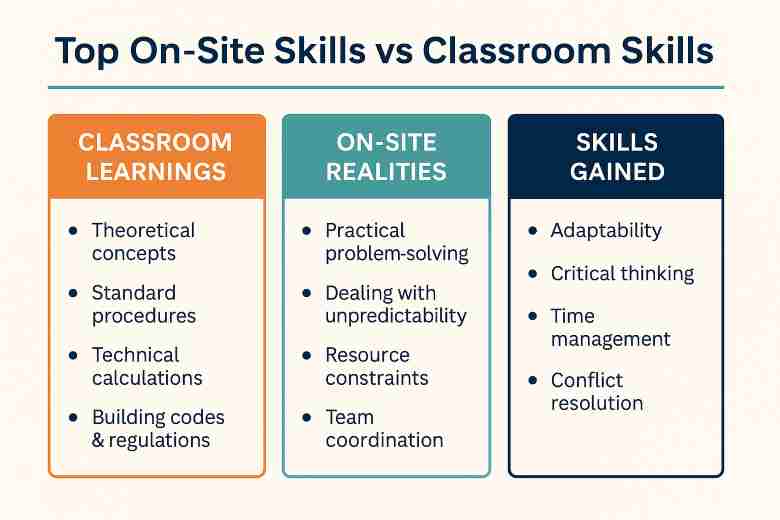Last Updated on May 6, 2025 by Admin
College gives you the theory, but life on a construction site teaches you reality. From safety protocols to managing unpredictable challenges, this guide reveals what textbooks leave out. If you’re stepping onto a site for the first time, here’s what to truly expect.
This comprehensive guide aims to bridge that gap. Whether you’re a civil engineering student, recent graduate, or a young construction professional, this post will give you valuable real-life insights that colleges often miss. It’s your backstage pass into the raw, unscripted world of on-site construction.
Table of Contents
The Reality Check: Welcome to the Site
A construction site is not just bricks, beams, and bulldozers. It’s a living ecosystem where multiple teams coordinate seamlessly (or not), decisions are made under pressure, and field improvisation becomes a necessity.
Not sure where your civil engineering career is heading?
Get a personalized 5–10 year career roadmap with our AI Civil Engineering Career Simulator – including salary projections, best-fit roles, skill gaps, Gulf readiness and more.
Unlike a controlled classroom lab:
- Site conditions change daily due to weather, logistics, or supplier delays.
- Blueprints may require real-time adjustments.
- Workers may not always follow technical jargon, demanding strong communication.
“In college, a beam is perfectly rectangular. On site, it may have to avoid a pipe.”
You’ll face harsh weather, dusty environments, and tight schedules. Don’t be surprised if your first role is more about observing and learning than managing. The hands-on nature of the job demands humility, patience, and a readiness to roll up your sleeves.
Daily Routine of a Site Engineer
Here’s a sample timeline from a typical construction site in India:
| Time | Activity |
| 9:00 AM | Morning briefing + safety toolbox talk |
| 9:30 AM | Site walk + inspection of ongoing work |
| 11:30 AM | Coordination meeting with contractors |
| 1:30 PM | Lunch break |
| 2:30 PM | Supervise concrete pouring |
| 4:30 PM | Quality check and reporting |
| 6:00 PM | Debrief with the Project Manager |
What You Actually Do
- Take material measurements
- Verify contractor bills
- Ensure safety compliance
- Manage junior staff and site labor
- Capture photographic evidence for records
- Monitor concrete slump and curing
- Update daily progress reports
- Check BBS against the actual rebar binding
Over time, you’ll develop an internal clock for site rhythms — from material arrivals to concrete pouring slots. Mastering this flow is essential to becoming an efficient site engineer.
Safety First: What Books Don’t Emphasize Enough
Safety isn’t just a lecture topic. It’s a matter of life and death.
Key Takeaways:
- Always wear PPE. No exceptions.
- Never skip toolbox talks.
- Learn emergency evacuation plans.
- Understand electrical and height-related risks.
- Stop work if safety is compromised.
Common Hazards:
- Working near live power lines
- Slippery scaffolding during monsoon
- Lack of fall protection
- Inhalation of cement dust and silicates
Real-site mantra: “Production can wait. Safety can’t.”
Real-World Construction Challenges
Books assume ideal conditions. Reality doesn’t.
Common Challenges:
- Material delays due to strikes or traffic
- Labor absenteeism during festivals
- Mid-project scope changes
- Unforeseen soil conditions
- Equipment breakdown
- Miscommunication between structural and MEP teams
Quick Fixes You Learn:
- Substitute materials with engineer approval
- Micro-planning of daily tasks
- Weather-based schedule buffering
- Engaging with local suppliers for quick turnarounds
- Reworking poor shuttering
Lessons You Learn Only On-Site
1. How to Deal With Conflicts
Contractors blaming others for the delay? Get ready to negotiate. A calm head and solid documentation help solve disputes before they escalate.
2. Improvisation Is Key
You’ll often be required to take calls on site without waiting for the head office. Trust your training, but learn to adapt.
3. Respect Labor Knowledge
Veteran masons and bar benders often spot flaws your software doesn’t. Value their input.
4. Reading Between the Lines
Drawings show theory. The field shows practical reality. Learn to foresee clashes between drawings and execution.

Soft Skills: The Hidden Curriculum
Colleges ignore soft skills that are vital on-site.
Must-Have Skills:
- Communication (Local language)
- Leadership
- Conflict resolution
- Time management
- Decision-making under pressure
- Adaptability
- Persuasion and negotiation
The site isn’t just bricks and mortar — it’s also about people. Workers, supervisors, clients, and vendors each speak a different professional language. Your ability to communicate across this spectrum can make or break a project.
Want to uncover more real-world skills that colleges don’t teach civil engineers? Explore our in-depth guide here and future-proof your site readiness.
The Role of Technology on Construction Sites
From total stations to drones, construction tech is booming.
Tools You’ll Encounter:
- AutoCAD on tablets
- MS Project / Primavera
- Drones for surveying
- BIM 360 for real-time updates
- Construction Management Software (e.g., Procore)
- Laser levels and digital distance meters
Site automation is rising. Learn the basics of using tablets, cloud-based documentation, and real-time project dashboards. It’s no longer just about drawings — it’s about data.
Gender Dynamics and Inclusivity
While traditionally male-dominated, more women are entering site roles.
Challenges:
- Lack of proper restrooms
- Gender stereotypes
- Security concerns for night shifts
- Attitudinal bias in the labor force
Progress:
- Initiatives like CREDAI Women’s Wing are supporting inclusion.
- MNCs ensure equal opportunity policies.
- Safety audits now consider female workers
Inclusivity is rising, and it’s here to stay. Companies now offer mentorship and training programs aimed at onboarding more female site engineers.
Related Posts:
- How to Become a Project Manager
- The Diverse and Dynamic Pathways of the Construction Career Landscape
- Finding the Right Balance: On-Site vs. Office Work for Civil Engineers
- House Cleaner: Tips for Finding the Right One
The Emotional Side of Site Work
Emotional Highs and Lows:
- Seeing your first completed slab — incredibly satisfying.
- Facing a collapsed formwork — nerve-wracking and humbling.
Mental fatigue is real. Long hours, intense heat, and dealing with multiple people can drain you. Learn to manage stress with time blocks, hydration, music during commute, and mindfulness practices.
How Site Work Shapes Long-Term Careers
The site is where true engineers are built. Your hands-on experience lays the foundation for future roles in planning, quality, contracts, and even leadership.
Career Roles After Site Work:
- Planning Engineer
- Quality Control Head
- Project Manager
- Contracts & Billing Manager
- Site Safety Manager
Many of today’s top executives started on-site, dirty boots and all.
Tips for Students and Interns
- Always carry a site diary and take notes
- Learn to read bar bending schedules (BBS)
- Ask questions. Lots of them.
- Volunteer for documentation tasks
- Stay humble; field experience trumps degrees
- Understand how drawings translate into execution
- Learn the basics of material testing (slump test, cube test)
Final Thoughts
Life on a construction site is challenging, unpredictable, and immensely rewarding. No textbook can substitute the experience of solving problems in real time, dealing with weather, materials, and human dynamics on-site.
If you’re about to step onto your first construction site, take this article as your unofficial prep manual.
Share this post with someone starting their construction journey.
Explore more on ConstructionPlacements.com for career tips and updates.
FAQs
What is the daily routine like on a construction site?
A typical day on a construction site includes a morning safety briefing, site walkthroughs, supervising labor and subcontractors, attending coordination meetings, checking material deliveries, and documenting progress through reports and photos.
How important is safety on a construction site?
Safety is paramount on construction sites. Daily PPE checks, toolbox talks, hazard assessments, and compliance with safety protocols are non-negotiable. Neglecting safety can lead to severe injuries, legal liabilities, or even fatalities.
What skills do you need apart from engineering knowledge?
Apart from technical knowledge, essential skills include clear communication, team coordination, conflict resolution, adaptability, time management, and the ability to make quick decisions under pressure.
What are the biggest surprises for fresh graduates on-site?
Fresh graduates are often surprised by the gap between academic theory and real-world execution. They’re also taken aback by the fast-paced environment and the level of on-the-spot responsibility they’re entrusted with from day one.
Can women engineers thrive in construction site roles?
Yes, women engineers are increasingly thriving in construction. With improved inclusivity, mentorship programs, and HR policies promoting diversity, women are successfully taking up roles in site execution, planning, safety, and project management.


